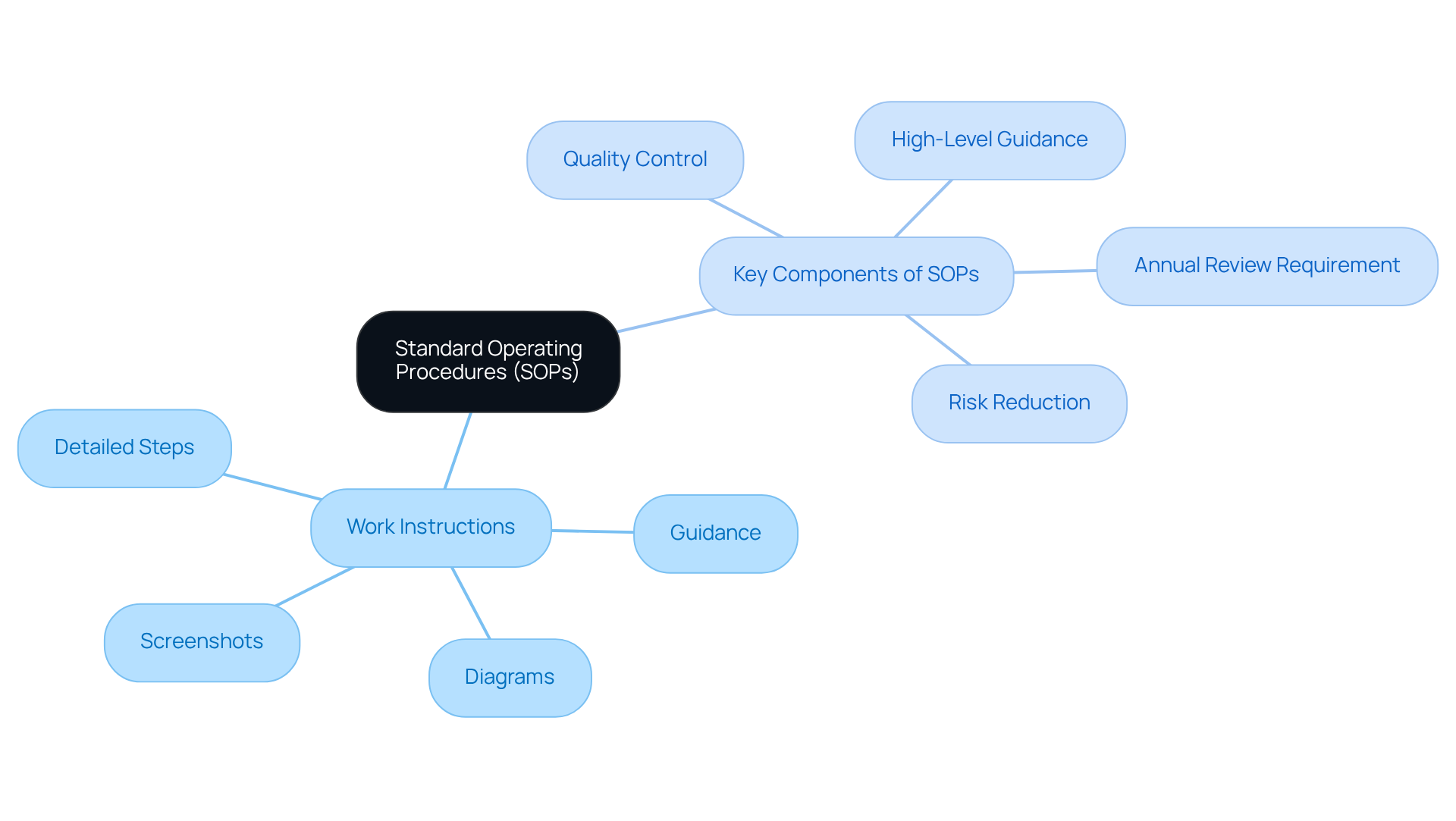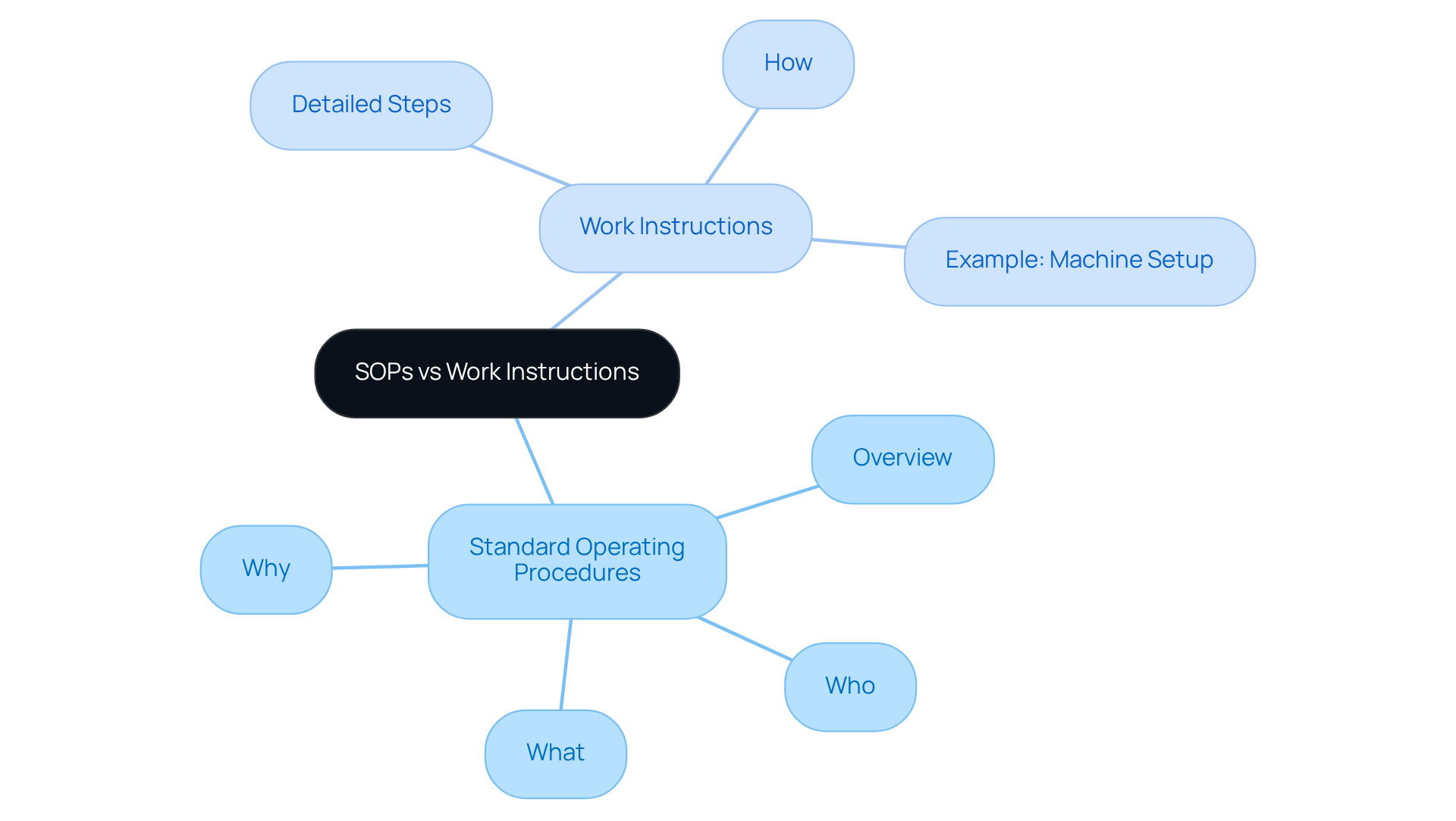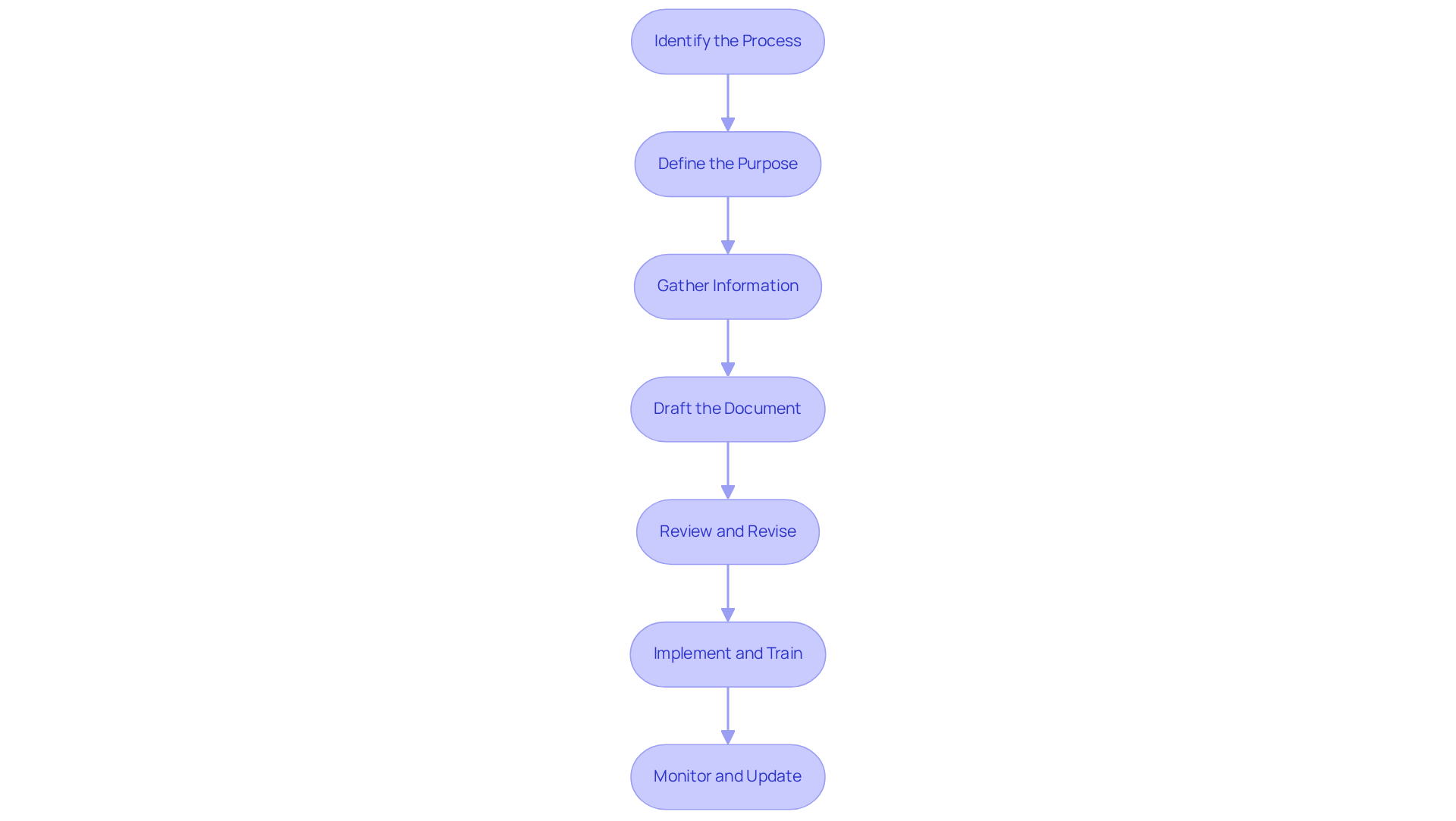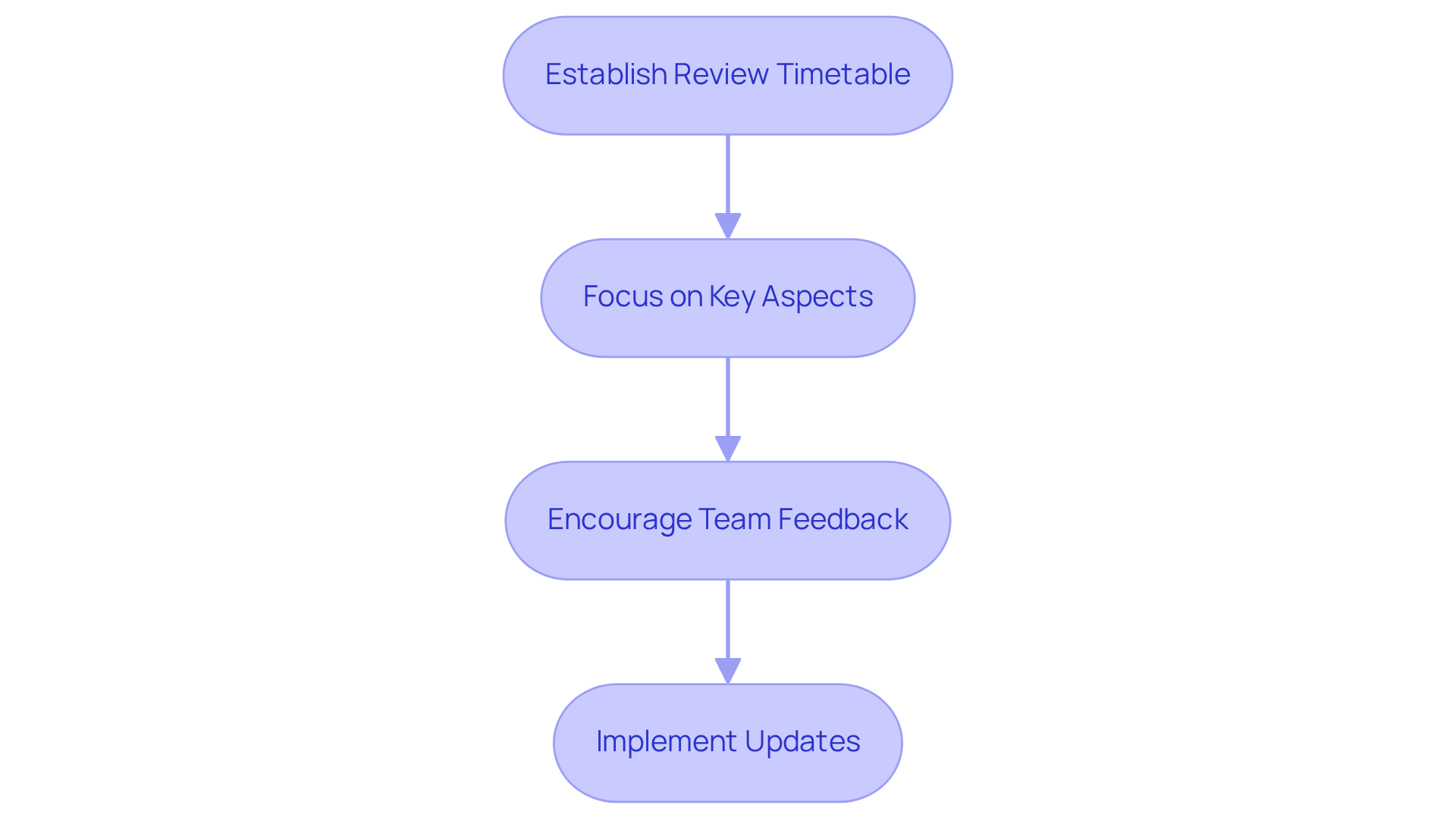
Remote Team Documentation Strategies
|
October 17, 2025
|
Difference Between SOP and Work Instruction: Key Insights for Operations
Overview
You might be wondering what sets Standard Operating Procedures (SOPs) apart from Work Instructions. Well, here's the scoop:
- SOPs give you a broad overview of processes.
- Work Instructions dive into the nitty-gritty, offering detailed steps for carrying out tasks within that framework.
Think of SOPs as your roadmap for consistent task execution. Now, when it comes to Work Instructions, they’re like your trusty guide, complete with precise details, diagrams, and even screenshots to help employees perform their duties effectively. Pretty handy, right?
Key Highlights:
- Standard Operating Procedures (SOPs) provide guidelines for consistent task execution, serving as a roadmap for employees.
- Work Instructions are detailed documents that specify how to perform tasks within the SOP framework, often including diagrams and screenshots.
- The key difference is that SOPs offer a broad overview of processes, while Work Instructions provide specific steps for task execution.
- Creating effective SOPs involves identifying the process, defining the purpose, gathering information, drafting the document, reviewing it, training staff, and monitoring updates.
- Regular reviews of SOPs and Work Instructions are essential for maintaining relevance, clarity, and compliance with regulatory standards.
- Feedback from team members is crucial for updating documentation, which can lead to improved operational efficiency and reduced errors.
Introduction
You might be wondering why understanding the differences between Standard Operating Procedures (SOPs) and Work Instructions is so crucial for organizations aiming for operational excellence. Well, here’s the scoop: while SOPs lay out a broad framework for processes, Work Instructions dive right into the nitty-gritty steps needed to get tasks done effectively. This distinction not only clears up any confusion but also helps teams tackle their responsibilities with confidence. But let’s be real—many organizations still struggle with how to implement and maintain these documents effectively. So, what can you do to bridge that gap and make sure your documentation keeps up with your operations? Let’s explore some strategies together!
Define Standard Operating Procedures and Work Instructions
You might be wondering what [Standard Operating Protocols (SOPs)](https://sowflow.io) are all about. Well, they’re essentially your go-to guidelines that help keep things consistent when carrying out a specific function. Think of them as a roadmap for employees, ensuring that tasks get done efficiently and reliably.
Now, let’s talk about Work Instructions. These are a bit more detailed and specific, showing you exactly how to perform a particular task within the SOP framework. They often include handy guidance, diagrams, or even screenshots to make everything crystal clear.
The difference between SOP and work instruction is significant, as both play crucial roles in maintaining quality and adherence in operations, but they each have their own unique purpose in the documentation world.
So, what’s your experience with documentation? Are there challenges you face that could use a little clarity?

Differentiate Between SOPs and Work Instructions
You might be wondering about the difference between SOP and work instruction, especially since both aim to standardize processes. Well, here’s the scoop: SOPs provide a broad overview of a process, covering the who, what, and why, while task guidelines zoom in on the how.
For instance, imagine an SOP for a manufacturing process—it would outline the overall workflow and the roles involved. On the flip side, a work instruction gets down to the nitty-gritty, detailing the exact steps an operator needs to follow to set up a machine.
Understanding the difference between SOP and work instruction is key! It helps teams create the right documentation for their needs, leading to smoother operations and better efficiency.
So, what documentation challenges have you faced? Let’s explore some solutions together!

Create Effective SOPs and Work Instructions: A Step-by-Step Guide
- Identify the Process: So, you’re looking to record a specific process? Start by selecting the one that needs your attention. Chat with stakeholders to get their insights into the workflow and its little quirks.
- Define the Purpose: What’s the goal here? Clearly spell out the purpose to highlight the difference between SOP and work instruction. Knowing what you want to achieve will help you direct the records effectively.
- Gather Information: Time to collect some intel! Gather all the necessary information, from existing documentation to industry best practices and team input. This way, you ensure you’ve got everything covered.
- Draft the Document: Now, let’s get writing! Start composing your SOP or procedure using clear and concise language. If you’re working on standard operating procedures, focus on the big picture; to clarify the difference between SOP and work instruction, provide detailed, easy-to-follow steps for task guidelines.
- Review and Revise: Got a draft? Share it with your stakeholders for their feedback. Revise the document based on their input to boost accuracy and clarity, making sure it meets everyone’s needs.
- Implement and Train: Once you’re all set, roll out the SOP or procedural guideline and hold some training sessions for your team. This way, you ensure everyone understands and can use it effectively.
- Monitor and Update: Don’t forget to keep an eye on the document! Regularly review it to ensure it stays relevant and effective, updating it as needed to reflect any changes in processes or best practices.

Maintain and Update Your Documentation for Continuous Improvement
To keep your SOPs and work guidelines effective, you might be wondering about the difference between SOP and work instruction and how to establish a structured review timetable. Ideally, aim for quarterly or bi-annual reviews tailored to the specific processes you have in place. Each review should focus on a few key aspects:
- Relevance: Make sure the information is accurate and relevant to your current operations.
- Clarity: Check that the instructions are straightforward and easy to understand.
- Compliance: Ensure the documents align with the latest regulatory standards.
It's super important to encourage your team members to share their feedback on how usable and effective the materials are. This input can really guide the necessary updates, allowing your documentation to evolve alongside your processes and organizational needs. Frequent updates have been shown to significantly boost the effectiveness of standard operating procedures and highlight the difference between SOP and work instruction, leading to better operational efficiency and compliance.
Now, let’s dive into a real-world example. As Anastasia Masadi, a Product Owner, puts it, "SowFlow has transformed the way we document work and deliver to our clients. I no longer need to take each screenshot separately or leave the browser while creating SOPs and training materials. SowFlow has truly given me time back in my life." This testimonial shows how organizations that focus on continuous improvement in their documentation practices—especially with tools like SowFlow—can achieve better relevance, clarity, and compliance. In turn, this leads to fewer errors and happier employees, contributing to a more agile and responsive business environment.

Conclusion
You might be wondering why understanding the difference between Standard Operating Procedures (SOPs) and Work Instructions is so crucial for your organization. Well, think of SOPs as the big picture framework that lays out the who, what, and why of your processes. On the other hand, Work Instructions zoom in on the nitty-gritty details of how to get those tasks done within that framework. This clarity not only makes workflows smoother but also boosts compliance and efficiency all around.
Throughout this article, we’ve shared some key insights on how to create and keep these important documents up to date. From pinpointing the processes and defining their purposes to drafting, reviewing, and putting these documents into action, each step is vital for keeping operations running like a well-oiled machine. Plus, we can’t forget about the importance of regular updates and team feedback—after all, continuous improvement can really amp up the effectiveness of your SOPs and Work Instructions.
In today’s fast-paced operational world, making the development and upkeep of these documents a priority isn’t just a nice-to-have; it’s a must. Organizations that take the time to invest in clear, up-to-date SOPs and Work Instructions will find themselves in a much better position to adapt to changes and boost productivity. By embracing best practices in documentation, you and your team can create a culture of clarity and efficiency, leading to greater success and satisfaction in your operations. So, why not take the plunge and explore how you can enhance your documentation today?
Frequently Asked Questions
What are Standard Operating Procedures (SOPs)?
Standard Operating Procedures (SOPs) are guidelines that help maintain consistency in carrying out specific functions within an organization. They serve as a roadmap for employees to ensure tasks are completed efficiently and reliably.
What are Work Instructions?
Work Instructions are detailed documents that provide specific guidance on how to perform a particular task within the SOP framework. They often include helpful elements like diagrams or screenshots to enhance clarity.
What is the difference between SOPs and Work Instructions?
The main difference is that SOPs provide general guidelines for consistency in operations, while Work Instructions offer detailed steps for completing specific tasks. Both are essential for maintaining quality and adherence in operational processes.
👍
What others are liking
5 Steps to outline your ideal documentation structure
5 MINS READ
Where to start the your journey of mapping out your ideal documentation structure, aligning it with the very heartbeat of your organization?
Defining a winning level of detail in your process
3 MINS READ
What is too much detail, and what is too little? This article described in that winning level detail about what detail is enough.





